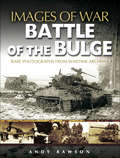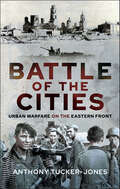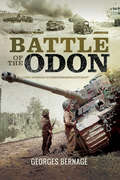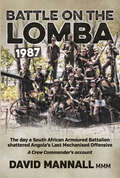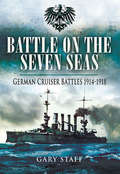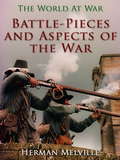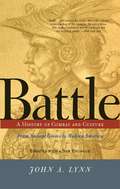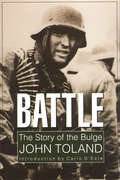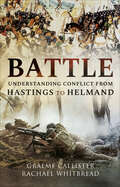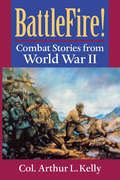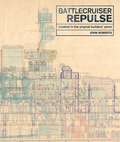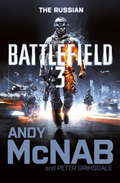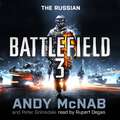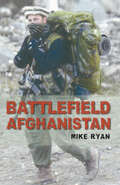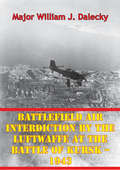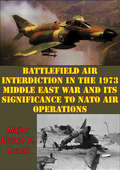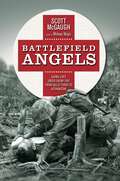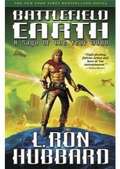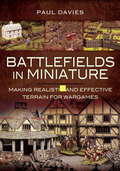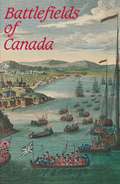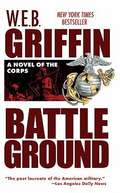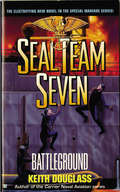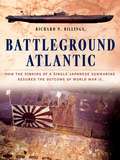- Table View
- List View
Battle of the Bulge: Rare Photogaphs from Wartime Archives (Images of War)
by Andy RawsonDramatic photographs of Nazi Germany’s shocking Ardennes Offensive that nearly turned the tide of World War II—from the author of In Pursuit of Hitler.Hitler’s desperate last throw during the depths of winter 1944/45 came perilously close to being a major disaster for the Allies. Their offensive through the Ardennes fell on the Americans and caught them totally by surprise. Unaccustomed to setbacks, the situation was for a time extremely serious and in some areas panic set in and events went out of control. It was only after the most bitter fighting and massive reinforcement that the rot was stopped. In this book the drama of those worrying weeks is captured in superb photographs.
Battle of the Cities: Urban Warfare on the Eastern Front
by Anthony Tucker-JonesA concise and vivid history of the urban war on the Eastern Front. The Stalingrad battle and the Leningrad siege were just two of the brutal, devastating urban conflicts that marked the awful struggle between Germany and the Soviet Union during the Second World War. The cities were strategic fixed points in the sweeping advances and retreats of the opposing armies across eastern Europe. Yet no one has concentrated on these city battles before or has sought to tell the story of the campaigns through the fighting that took place in and around them. That is Anthony Tucker-Jones’s purpose in this concise and vivid history of the urban war on the Eastern Front. Early in the war, during the Wehrmacht’s crushing offensives of 1941 and 1942, the Red Army was forced out of a series of key cities. Moscow was threatened, Leningrad surrounded. Then, after the climactic battle at Stalingrad, the Red Army with increasing confidence, speed and power drove the Germans from the Soviet and East European capitals they had occupied. The final urban battles were fought in Germany's cities, culminating in Berlin. As he traces the course of the fighting for each city, Anthony Tucker-Jones looks at the local circumstances, the opposing forces, the strategic significance and the tactics employed. He focuses not only on the destruction and cruelty of such warfare, but on the heroism displayed on both sides and on the fate of the civilians who found themselves on the front line.
Battle of the Odon
by Georges BernageThe Battle of the Odon evokes the clash between the British Army and the II SS-Panzer Korps, as they attacked across the Odon Valley during Operation "Epsom" in June 1944.Using contemporary photographs and documents, this book provides day-by-day details of the operation that was just one part of what is commonly referred to as the 'Battle of Normandy'.
Battle on the Lomba 1987: A Crew Commander's Account
by David MannallA South African national serviceman recounts becoming a soldier and an ensuing David-and-Goliath face-off against Angolan armed forces in 1987.The climactic death-throes of Soviet Communism during the 1980s included a last-gasp attempt at strategic franchise expansion in southern Africa. Channeled through Castro’s Cuba, oil-rich Angolan armed forces (FAPLA) received billions of dollars of advanced weaponry and thousands of armored vehicles. Their intent: to eradicate the US-backed Angolan opposition (UNITA), then push southwards into South Africa’s protectorate SWA/Namibia, ostensibly as liberators.1985 saw the first large-scale mechanized offensive in southern African history. Russian Generals planned and oversaw the offensive but didn’t account for the tenacity of UNITA (supported by the South African Defense Forces, SADF) or the rainy season. The ‘85 offensive floundered in the mud, and FAPLA returned to their capital Luanda. The South Africans stood down, confident their “covert” support for UNITA had demonstrated the folly of prosecuting war so far from home against Africa’s military Superpower. However, they were mistaken. Fidel and FAPLA immediately redoubled their efforts, strengthening fifteen battalions with even more Soviet hardware while Russian and Cuban specialists oversaw troop training.As Cuban and Angolan fighter pilots honed their skills over the skies of Northern Angola, David Mannall, a normal seventeen-year-old kid completing high school, was preparing for two years of compulsory military service before beginning Tertiary education. Through a series of fateful twists, he found himself leading soldiers in several full-scale armored clashes, including the largest and most decisive battle on African soil since World War II.This is a David and Goliath story that has never been truthfully told. The author reveals how Charlie Squadron, comprising just twelve 90mm AFVs crewed by thirty-six national servicemen, as part of the elite sixty-one Mechanized Battalion, engaged and effectively annihilated the giant FAPLA 47th Armored Brigade in one day—3 October 1987. Their 90mm cannons were never designed as tank-killers, but any assurances that it would never be used against heavy armor were left in the classroom during the three-month operation and never more starkly than the decisive “Battle on The Lomba River.” The Communist-backed offensive died that day along with hundreds of opposition fighters.47th Brigade survivors abandoned their remaining equipment, eventually joining the 59th Brigade in what became a full-scale retreat of over ten thousand soldiers to Cuito Cuanevale. The myth perpetuated by post-apartheid politicians goes something like this: “The SADF force that destroyed 47th Brigade on 3 October numbered 6,000 men and that all the hard yards were run by the long-suffering UNITA!” The inconvenient truth is that there were just 36 South African boys on the frontline that day, but it is also true to say they would never have achieved such a stunning victory without the support of many more. This is their story.
Battle on the Seven Seas: German Cruiser Battles, 1914–1918
by Gary StaffThe cruisers of the Imperial German Navy (Kaiserlische Marine) were active throughout the First World War and saw action all around the globe, tying up valuable Allied naval resources out of all proportion to their number. Drawing on firsthand accounts and original research in German archives, the author here describes in detail some of their most significant and/or audacious battles.Some are well known, such as their role at Jutland, Goeben's attack on the Russian fleet (which brought Turkey into the war) and the sagas of Konigsberg and Emden; but others have been unduly neglected. Gary Staff deliberately focuses on the latter to bring new material to the attention of the reader and to demonstrate the global span of the cruisers' activities. The blow-by-blow accounts of the action (drawing heavily on firsthand Allied and especially German accounts) are supported by dozens of photographs, many previously unpublished, from the author's own impressive collection.The battles described include: Helgoland Bight, August 1914; Coronel, November 1914; Falklands December, 1914; Doggerbank, January 1915; Goeben and the Russian fleet, Black Sea, May 1915; Ostergarn July 1915; Jutland, 1916; Second Heligoland Bight, November 1917; Imbros, January 1918.
Battle over the Atlantic: Royal Australian Air Force in Coastal Command 1939-1945
by John QuaifeAt the outbreak of World War II, somewhat by accident — and just as the first shots of the war were fired — young Australian airmen from the Royal Australian Air Force were engaged in operations that would become known collectively as the Battle of the Atlantic. Arguably lesser-known than air campaigns in other theatres, large numbers of Australians who volunteered for service with Royal Australian Air Force, found themselves fighting in this battle. Australians were there at the outbreak and many would go on to fly some of the final missions of the war in Europe. This book captures some of the experiences of the Royal Australian Air Force members who served with Coastal Command and, through the weight of numbers alone, stories of the Sunderland squadrons and the Battle of the Atlantic dominate the narrative. Being critical to Britain&’s survival, the battle also dominated Coastal Command throughout the war but Australians served in a surprising variety of other roles. The nature of many of those tasks demanded persistence that could only be achieved by large numbers of young men and women being prepared to &‘do what it took&’ to get a tedious and unrewarding job done. Over 400 did not come home.
Battle-Pieces and Aspects of the War: Civil War Poems (The World At War)
by Herman MelvilleBattle-Pieces and Aspects of the War (1866) is the first book of poetry published by American author Herman Melville. The volume is dedicated "To the Memory of the Three Hundred Thousand Who in the War For the Maintenance of the Union Fell Devotedly Under the Flag of Their Country" and its 72 poems deal with the battles and personalities of the American Civil War and their aftermath. (Excerpt from Wikipedia)
Battle: A History of Combat and Culture
by John A LynnBattle: A History of Combat and Culture spans the globe and the centuries to explore the way ideas shape the conduct of warfare. Drawing its examples from Europe, the Middle East, South Asia, East Asia, and America, John A. Lynn challenges the belief that technology has been the dominant influence on combat from ancient times to the present day. In battle, ideas can be more far more important than bullets or bombs. Carl von Clausewitz proclaimed that war is politics, but even more basically, war is culture. The hard reality of armed conflict is formed by - and, in turn, forms - a culture's values, assumptions, and expectations about fighting. The author examines the relationship between the real and the ideal, arguing that feedback between the two follows certain discernable paths. Battle rejects the currently fashionable notion of a "Western way of warfare" and replaces it with more nuanced concepts of varied and evolving cultural patterns of combat. After considering history, Lynn finally asks how the knowledge gained might illuminate our understanding of the war on terrorism.
Battle: The Story of the Bulge
by Carlo D'Este John Toland"The perspective of 15 years, painstaking research, thousands of interviews, extensive analysis and evaluation, and the creative talent of John Toland [paint] the epic struggle on an immense canvas. . . . Toland writes with the authority of a man who was there. . . . He tastes the bitterness of defeat of those who surrendered and writes as if he had the benefit of the eyes and ears of soldiers and generals on the other side of the line. . . . If you could read only one book to understand generals and GIs and what their different wars were like this is the book."—Chicago Sunday Tribune "The author has devoted years to studying memoirs, interviewing veterans and consulting military documents, both German and American. He also has revisited the old battlefields in Belgium and Luxembourg. . . . Toland has told the whole story with dramatic realism. . . . It is a story of panic, terror and of high-hearted courage."—New York Times Book Review "For the first time in the growing literature of World War II, the inspiring story of the stubborn, lonely, dogged battle of the Americans locked in this tragic salient is told. . . . gripping . . . You cannot put it down once you start it."—San Francisco Chronicle
Battle: Understanding Conflict from Hastings to Helmand
by Graeme Callister Rachael WhitbreadWhat are the critical factors that determine the outcome of battles? Which is more decisive in a clash of arms: armies or the societies they represent? How important is the leadership of the commanders, the terrain over which the armies fight, the weapons they use and the supplies they depend on? And what about the rules of war and the strategic thinking and tactics of the time? These are among the questions Graeme Callister and Rachael Whitbread seek to answer as they demonstrate the breadth of factors that need to be taken into account to truly understand battle. Their book traces the evolution of warfare over time, exploring the changing influence of the social, political, technological and physical landscape on the field of battle itself. They examine how the motivation of the combatants and their methods of fighting have changed, and they illustrate their conclusions with vivid, carefully chosen examples from across a range of Western European military history, including the Norman Conquest, the Hundred Years War, the Wars of Religion, the Napoleonic Wars and the world wars, and beyond. By exploring the wide range of interconnected factors that influence the results of battles, the authors broaden the study of this aspect of military history from a narrow focus on isolated episodes of conflict. Their original and thought-provoking writing will be fascinating reading for all students of warfare.
BattleFire!: Combat Stories from World War II
by Col. Arthur L. Kelly&“From Pearl Harbor to Leyte Gulf and Okinawa to Iwo Jima, the stories are presented as the individual soldiers, sailors, and marines lived them.&” —Gun Week Pearl Harbor, December 7, 1941: High on the bridge of the USS West Virginia Sfc. Lee Ebner was looking forward to the end of his watch and a relaxed Sunday morning breakfast. But the two low-flying planes painted with rising sun insignia and bearing down on the ship had other plans for him and his fellow seamen. Ten hours later, at Clark Field in the Philippines, Pfc. Jack Reed felt the brunt of another Japanese air attack and within weeks found himself a part of the gruesome Bataan Death March that was to claim the lives of hundreds of his comrades. On another continent, four years into the war, Capt. Benjamin Butler led his exhausted company up a steep, fog-shrouded Italian mountain toward a well entrenched German defensive position. The odds against their survival were appalling, though worse was to come in the months ahead. Such were the experiences of many young men-plucked from their local communities all across America, trained for war, and hurled into the strange reality of combat thousands of miles from home. In this stunning collection of World War II oral histories, Arthur Kelly recreates the experiences of twelve young men from Kentucky who survived the seemingly unsurvivable, whether in combat or as prisoners of war. &“A fascinating collection . . . A story of men at their best in the worst of times.&” —Louisville Courier-Journal &“This excellent book continues the current trend of exploring the individual soldier&’s experiences in World War II.&” —Military Review
Battlecruiser Repulse: Detailed in Original Builders' Plans
by John RobertsAn outstanding illustrated reference revealing the painstaking work of draftsmen in recording every detail of the famed British warship. The technical details of British warships were recorded in a set of plans produced by the builders on completion of every ship. Known as the &“as fitted&” general arrangements, these drawings represented the exact appearance and fitting of the ship as it entered service. Intended to provide a permanent reference for the Admiralty and the dockyards, these highly detailed plans were drawn with exquisite skill in multi-colored inks and washes that represent the acme of the draftsman&’s art. Today they form part of the incomparable collection of the National Maritime Museum at Greenwich, which is using the latest scanning technology to make digital copies of the highest quality. This book is one of a series based entirely on these drafts which depict famous warships in an unprecedented degree of detail—complete sets in full color, with many close-ups and enlargements that make every aspect clear and comprehensible. Extensive captions point the reader to important features to be found in the plans, and an introduction covers the background to the design. The subject of this volume was one of the last battlecruisers, elegant ships that combined a powerful armament with high speed, but were much criticized for their light protection. Throughout their existence, they were controversial—three were sunk at Jutland—and Repulse herself was famously lost to Japanese air attack at the outset of the Pacific War. Nevertheless, the type was highly prized: Repulse and her sister Renown were the only capital ships given sufficient priority to be designed, built, and completed during the course of the First World War, and substantial sums were spent on large-scale reconstruction during the 1930s. Both of these phases of the ship&’s life are fully documented in two separate sets of plans, which allow this novel form of anatomy to cover the whole life of the ship.
Battlefield 3: The Russian
by Peter Grimsdale Andy McNabAndy McNab at the top of his game, delivering pulse-pounding entertainment and awe-inspiring, widescreen action.Spetsnaz used to be a name to strike fear into the hearts of Russia's enemies. But now that the country has gone to the dogs, Dima Mayakovsky - once a revered figure inside the elite Special Forces unit - wants no part of it any more. But when a dangerous fugitive surfaces in Tehran, Dima is the man Kremlin wants to bring him in. There is no option: the ex-Spetsnaz legend must lead his team of battle-hardened operatives into combat, not something you can hide from the US recce satellites circling above.This means that Dima and his men become Marine Sergeant Henry 'Black' Blackburn's problem. As Iran descends into chaos, Dima and Black are forced to question everything they believed in, and to fight to survive, for their comrades, their honour and the lives of millions. They're on their own. And the clock is ticking?
Battlefield 3: The Russian (Battlefield #3)
by Peter Grimsdale Andy McNabSpetsnaz used to be a name to strike fear into the hearts of Russia's enemies. But now that the country has gone to the dogs, Dima Mayakovsky - once a revered figure inside the elite Special Forces unit - wants no part of it any more. But when a dangerous fugitive surfaces in Tehran, Dima is the man Kremlin wants to bring him in. There is no option: the ex-Spetsnaz legend must lead his team of battle-hardened operatives into combat, not something you can hide from the US recce satellites circling above.This means that Dima and his men become Marine Sergeant Henry 'Black' Blackburn's problem. As Iran descends into chaos, Dima and Black are forced to question everything they believed in, and to fight to survive, for their comrades, their honour and the lives of millions. They're on their own. And the clock is ticking?Read by Rupert Degas(p) 2011 Orion Publishing Group
Battlefield Afghanistan
by Mike RyanFrom interviews with his numerous contacts among the coalition forces stationed in Afghanistan, Mike Ryan has done what journalists have so far been unable to do.Battlefield Afghanistan is the first thorough-going account of the war in the former Taliban state: not the politics behind the conflict, but the actual situation for the men on the ground. Far from simply 'keeping the peace,' coalition forces in Afghanistan are currently involved in full-scale warfare with both al-Qaeda militants and the forces of the resurgent Taliban. Battlefield Afghanistan tells the real, inside story of the men under fire, based upon first-hand evidence from members of 3 Para, 16 Air Assault Brigade, the Royal Marines and the Special Forces community, together with the views and experiences of the US and French troops. As their accounts indicate, the hostilities faced have proved to be far greater than was anticipated, and the situation in Afghanistan far more serious than the politicians would like the public to realise.
Battlefield Air Interdiction By The Luftwaffe At The Battle Of Kursk - 1943
by Major William J. DaleckyThis study attempts to show the misapplication of tactical airpower by the Luftwaffe in support of German ground forces during the Battle of Kursk in July 1943. The analysis is based on an investigation of historical references and provides lessons learned which might be applied in future conflicts.The study shows that the Luftwaffe concentrated its efforts at Kursk on Close Air Support and neglected Battlefield Air Interdiction. This was primarily because Close Air Support had proven itself so successful in German experience prior to Kursk. However, the failure of the Luftwaffe to interdict Russian reinforcements at Kursk proved to be critical and contributed to the German defeat.Air planners must realize that a correct balance between Close Air Support and Battlefield Air Interdiction is essential to the efficient use of airpower during any tactical application in support of ground forces. Neither Close Air Support nor Battlefield Air Interdiction should gain primacy in doctrine, rather, a mix of the two should be applied on a situational basis.
Battlefield Air Interdiction In The 1973 Middle East War And Its Significance To NATO Air Operations
by Major Bruce A. BrantThis study is a historical analysis of battlefield air interdiction during the 1973 Middle East War. Its purpose is to draw conclusions, based on the historical findings, about the best way to employ BAI in the air land battle. Although the conclusions come from a Middle East War over ten years ago, they are examined in terms of the NATO environment.The tactical and technological developments of both Arab and Israeli air forces during the years 1967-1973 are examined in order to explain how both sides arrived at the doctrine they employed in the 1973 War. The Arabs established an intensive air defense network to deny the Israelis their strongest and most flexible weapons system. The Israelis believed that their Air Force would destroy Arab ground forces as it did in 1967. The confrontation of both doctrines had significant implications for the ground forces particularly the relative value assigned close air support and battlefield air interdiction.The study concludes that close air support is not the best use of air assets in a high density air defense environment. Battlefield air interdiction is more effective to the operational ground commander. Localized control of air defense systems is needed to allow the use of air to ground assets. The final conclusion is that suppression of enemy air defense systems is a joint service responsibility.
Battlefield Angels: Saving Lives Under Enemy Fire From Valley Forge to Afghanistan
by Scott Mcgaugh"The night air chilled Caspar Wistar as he walked alongside a wagon filled with medical supplies, part of an eleven-thousand-man army creeping toward a small Pennsylvania hamlet. He wondered if General George Washington's medical corps would again run short of wound dressings when battle met the sunrise."Thus opens the magisterial new book from Scott McGaugh, author of Midway Magic. In Battlefield Angels, McGaugh pays homage to the cadre of medics, corpsmen, nurses, doctors, surgeons, and medical technicians who have provided succor and healing to the more than 40 million warriors who have served in America's armed forces since the nation's founding.Scott McGaugh tells the story of Jonathan Letterman, a Union surgeon during the Civil War who is considered the father of American combat medicine. Letterman designed the first battlefield evacuation system after an unprepared medical corps at Bull Run left thousands of soldiers to die in the place where they were wounded. We also learn about Wheeler Lipes, a young navy corpsman and submariner with minimal medical training who on September 11, 1942, conducted the first-ever appendectomy at sea. And, we hear the story of Pfc. Monica Brown, the young army medic who was awarded the Silver Star for rescuing fellow soldiers from a disabled Humvee during an ambush in the Paktika province of Eastern Afghanistan in 2007. Brown is only the second woman in sixty years to receive the prestigious award. Through these stories and many others, McGaugh traces the captivating evolution of battlefield care, from the Revolutionary War to today's battles in Iraq and Afghanistan.In Battlefield Angels, McGaugh captures the in-the-trenches moments during which medics and corpsmen fought to save the lives of their comrades. Along the way, readers will learn the fascinating history of battlefield medicine and how it has benefited both military and civilian medical practice throughout American history. McGaugh also looks ahead to the future, where telemedicine and robotic surgery promise to transform the battlefield once again. In the end, Battlefield Angels both chronicles and pays homage to the men and women in arms who fight every day to save the lives of their fellow soldiers, sailors, and Marines.From the Hardcover edition.
Battlefield Bombers: Deep Sea Attack
by Martin W. BowmanFeaturing a unique selection of wide-ranging experiences of British and Commonwealth Bomber Command aircrew during World War Two, this new release details the deep sea bombing raids that occurred within this time-frame. The enduring bravery and fortitude of these bomber pilots is communicated through a series of first-hand recollections, as is their humour and occasional cynicism. All reflect the ethos, fear and bravery of these ordinary men, most of whom were plucked from 'civvy street' and thrust into a frightening, bitter conflict which was made even more dangerous by the lethal advance of technology.With characteristic self-effacing modesty, the pilots, gunners, navigators and engineers tell of acts of great heroism, of dreadful injuries bravely borne, and personal fears overcome in the heat of battle. A comprehensive account of RAF Bomber operations on the infamous German warship Tirpitz is included, alongside many other similarly dramatic episodes. The gentle and unassuming narratives convey the sense of purpose that these men felt, employed in some of the most dangerous yet vital operations of the war. It is a fitting tribute to those that survived and the many thousands who died in the struggle against Hitler's dreadful ambitions in Europe.
Battlefield Earth: A Saga of the Year 3000
by L. Ron HubbardSuspense, politics, war, humor and intergalactic finance. A towering masterwork of science fiction adventure and one of the best-selling science fiction novels of all time, L. Ron Hubbard's Battlefield Earth opens with breathtaking scope on an Earth dominated for 1,000 years by an alien invader and man is an endangered species. From the handful of surviving humans a courageous leader emerges Jonnie Goodboy Tyler, who challenges the invincible might of the alien Psychlo empire in a battle of epic scale, danger and intrigue with the fate of the Earth and of the universe in the tenuous balance. "Tight plotting, furious action and have at'em entertainment." --Kirkus Review
Battlefields In Miniature: Making Realistic And Effective Terrain For Wargames
by Paul Davies&“For the modeller and wargamer . . . looking for something more when recreating their battles in a table-top game or exhibiting their work.&” —José Manuél Rico Cortés (&“Mister JM&”), Miniaturas JM Like a good general, a good wargamer should have an eye for the ground. Just as the nature of the battlefield plays a central role in real warfare, so miniature wargames are greatly enhanced by realistic terrain. Besides, when you&’ve spent hundreds of hours collecting and painting your miniature armies, they surely deserve ground worth fighting for. Master terrain modeler Paul Davies takes the reader through the process of creating a visually appealing yet practical terrain system. First the techniques of making the basic landscape are explained, then a series of projects show how this can be adapted to suit different periods or geographic locations, from European farmland to Sudanese desert. There are then detailed chapters on adding vegetation, buildings, roadways, trench systems, and more. The clear, step-by-step instructions are clearly illustrated by numerous specially-taken photographs of the work in progress and Paul&’s inspirational finished pieces. &“Takes the reader through the process of creating a visually appealing yet practical terrain over which miniature battles may be fought . . . The book should be well received by wargamers and diorama builders alike. Recommended.&” —Military Modelling &“Inspiring . . . It&’s the detailed &‘build projects&’ and the huge number of images that really serve to make this book such a valuable resource for those who don&’t quite know where to start, or those who would like some inspiration and guidance to serve as a catalyst for their own research and modelling projects.&” —Tabletop Gaming
Battlefields of Canada
by Mary Beacock FryerBattlefields of Canada encompasses nearly 300 years of history and features sixteen of the most significant Canadian battles as well as some of the most comic or bizarre. Profusely illustrated with sketches, photographs, and detailed maps, each chapter sets the context of the battle in terms of the struggle of which it was part, and then describes the hour-by-hour events. A brief conclusion to each chapter assesses the consequences for the victors and losers, assigning its place in Canadian history. A chronology provides a comprehensive list of every Canadian battle since the early 1600s.
Battleground (Corps #4)
by W.E.B. GriffinW.E.B. Griffin is a bestselling phenomenom, an American master of authentic military action and drama. Now, in this electrifying new novel, he reveals the story of one of the bloodiest conflicts of the Pacific, the epic struggle for Guadalcanal...Daredevil pilot Charles Galloway learns the hard way how to command a fighter squadron. Lt. Joe Howard teams up with the Coastwatchers. Jack "No Middle Initial" Stecker leads his infantry battalion into the thickest of fighting, at a terrible price. And Navy Captain Pickering grabs a helmet and rifle to join the ranks at Guadalcanal...
Battleground (Seal Team Seven #6)
by Keith DouglassThe S.S. Roy Turner docked just off Kenya--on a goodwill call. At about midnight, they were dealt an unexpected blow. Colonel Maleceia staged a military coup--attacking the ship. One hundred sixty American sailors captured. Twenty-eight killed. Lieutenant Murdock and his SEALs are sent to restore justice. But the colonel is just getting started. He's attacking the U.S. Embassy in Nairobi--and declaring himself dictator. The SEALs will have to expand their mission as the odds turn against them.
Battleground Atlantic
by Richard N. BillingsOn June 24, 1944, U. S. Navy warplanes patrolling the Atlantic attacked and sank a Japanese submarine, the I-52. It was an event of enormous strategic importance. The I-52's mission was to return to Japan with the ingredients of a radiological bomb. Purchased from the Germans, this doomsday weapon-classified secret by the U. S. government for years after the war-could have contaminated vast areas of America for decades, killing millions slowly and painfully. Japan had intended to use it in an attack on the California coast until the mission was detected in an Allied intelligence coup equal to the breaking of the Enigma code. The I-52's resting place was discovered in 1995 by ship salvager Paul R. Tidwell. Author Richard N. Billings has worked with Tidwell-whose attempts to salvage the I-52's precious gold cargo continue-in bringing her secret mission to light. Finally, this is the story of how the I-52 mission may have influenced President Truman's decision to drop atomic bombs on Hiroshima and Nagasaki.
